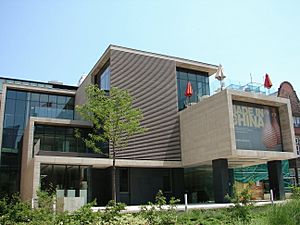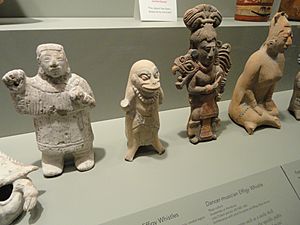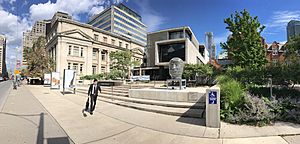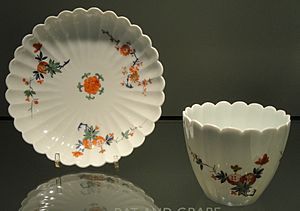Gardiner Museum facts for kids

Gardiner Museum from Queen's Park Crescent
|
|
| Established | 6 March 1984 |
|---|---|
| Location | 111 Queens Park Crescent, Toronto, Ontario, Canada |
| Type | Ceramics museum |
| Founder | George and Helen Gardiner |
| Architect | Keith Wagland, KPMB Architects (2004–06 expansion) Urbacon (general contractor of 2004–06 expansion) |
| Public transit access | |
The George R. Gardiner Museum of Ceramic Art, often called the Gardiner Museum, is a special place in Toronto, Ontario, Canada. It's a museum all about ceramics, which are art pieces made from clay and then fired, like pottery or porcelain. You can find it on the University of Toronto's St. George campus, right in the middle of downtown Toronto.
The museum building is quite large, about 4,299 square meters (46,276 square feet). It was designed by Keith Wagland. Later, KPMB Architects and Urbacon helped make it even bigger and better. The museum was started by George and Helen Gardiner. It first opened its doors to the public on March 6, 1984.
For a while, the Royal Ontario Museum (ROM) helped manage the Gardiner Museum. But in 1996, the Gardiner Museum became independent again. The museum closed for a bit in 2004 for big renovations. It reopened in 2006, looking brand new!
Today, the museum has a huge collection of over 4,000 ceramic pieces. These include two main types: earthenware and porcelain. Besides showing its own collection, the museum also hosts cool exhibitions of modern ceramic art. It's connected to other important Canadian museum networks too.
Contents
History of the Museum
How the Museum Started
In the early 1980s, George and Helen Gardiner wanted to show their amazing collection of ceramic art. They first thought about displaying it at the Royal Ontario Museum. But when that didn't work out, they decided to open their very own museum!
The museum building was finished in 1983. The Gardiner Museum officially opened on March 6, 1984. To help run the museum, a group of volunteers from the Royal Ontario Museum started helping out in 1983. They even had their first official meeting shortly after the museum opened.
Becoming Independent
The museum started offering tours to visitors in the spring of 1985. A few years later, in 1987, the Royal Ontario Museum took over managing the Gardiner Museum to help with money matters.
However, in 1996, the Gardiner family gave more money to the museum. With this support, and help from the government, the Gardiner Museum became independent again. It officially separated from the ROM on January 1, 1997. After that, a special group of people called a Board of Trustees started managing the museum.
Big Changes and New Art
In 2000, George Gardiner asked an architect named Bruce Kuwabara to design a ceramic art show for the museum. The show was a big hit! Because of its success, Kuwabara was then asked to redesign and expand the whole museum building.
In January 2004, the museum closed its doors to the public for these big renovations. They worked on the first two floors and added a brand new third floor. Even while closed, the museum kept its offices open elsewhere and continued to offer educational programs. The museum reopened in June 2006, though the full renovation wasn't completely finished until 2008.
To attract more visitors, the museum started a special art program in 2012. In 2013, a cool striped-head sculpture by Jun Kaneko was placed permanently outside the museum. Later, in 2018, another public art piece called Cracked Wheat by Shary Boyle was added to the museum's courtyard.
Museum Building and Design
The Gardiner Museum building is located on Queen's Park Crescent. It's part of Victoria University, which is connected to the University of Toronto. The closest subway station is Museum station.
The building was finished in 1983 and cost about C$6 million. It was originally two stories tall and about 2,969 square meters (31,958 square feet). The design by Keith Wagland was a mix of neoclassical and modernist styles. It was built at the back of the property so that people could still see the beautiful Lillian Massey Building next door. The museum building itself seemed to hang over towards Queen's Park. For many years, it had a simple pink granite outside.
Modern Look and Expansion
From January 2004 to June 2006, the museum closed for a huge C$25 million renovation and expansion. Even though it reopened in 2006, the project wasn't fully done until 2008. Bruce Kuwabara led the design for this big change.
As part of the renovation, the outside of the building was changed. It was covered with Indiana limestone and black granite. New, sharp, vertical windows were also added. The architects chose limestone to match the Lillian Massey building nearby. They also made the museum blend in with the Annesley Hall building to the south.

The renovation also added a third floor, making the building much bigger by about 1,330 square meters (14,318 square feet). This new floor included a restaurant with 50 seats, an outdoor terrace, and a large exhibition gallery of about 372 square meters (4,000 square feet).
Inside, the lobby was redesigned with a long wooden reception desk to welcome visitors. The three main galleries, learning areas, and the gift shop were also updated. The museum wanted to make sure the focus was on the amazing ceramic pieces themselves, not just big empty spaces. The special display cases for the art were also redesigned.
In 2017, the museum's gift shop was redesigned. A new ceramic studio was also added in the lobby where artists can work.
Amazing Art Collection
The Gardiner Museum's main goal is to collect, protect, lend, and show ceramic art and other related items. As of July 2019, the museum's permanent collection has over 4,000 objects! These pieces are either given to the museum, bought by it, or left to it in wills. They are held for everyone to enjoy. When the art isn't on display, it's kept safe in a special room with controlled temperature and humidity.
Types of Ceramics
The museum's collection is mostly divided into two main types of ceramics: earthenware and porcelain.
- Earthenware: This part of the collection mainly includes ceramics from the Americas before Christopher Columbus arrived (called pre-colonial Americas). These pieces date from 3500 BCE to 1550 CE. Many come from the American Southwest, Central America, Mesoamerica, and South America. The museum also has European earthenware from the 14th to 18th centuries, like Italian maiolica and English delftware.

- Porcelain: The museum's porcelain collection mostly features pieces from Europe. Some of the first pieces collected by George and Helen Gardiner were Meissen porcelain from Germany. The museum has European porcelains from the 18th and 19th centuries, including pieces from Austria, England, France, Germany, Italy, and Switzerland. It also has special figurines and decorated pieces. The 19th-century collection includes pieces from Mintons, which made a type of porcelain called bone china.
The museum also has porcelains from China and Japan, including beautiful Chinese blue and white porcelains.
Besides these, the museum has some modern and contemporary ceramic pieces from the 1950s to today. While it's mostly a ceramics museum, it also has a few non-ceramic items that are related to its ceramic collection.
Research Library
The museum has a special place called the Gail Brooker Ceramic Research Library. It's part of the University of Toronto Library System. The library started in 1988 when George R. Gardiner donated many books, journals, and other materials about ceramics. Now, it has over 2,500 books!
Even though the library is open to everyone, you can't borrow books to take home. It's a research library, so you can only read the items while you are there.
Fun Programs and Activities
The Gardiner Museum often hosts and organizes special art shows that travel to different places. Besides showing amazing ceramic art, the museum also offers fun educational programs. One popular activity is a two-hour drop-in pottery class that you can take throughout the year. It's a great way to try making your own ceramic art!
See also
 In Spanish: Museo Gardiner para niños
In Spanish: Museo Gardiner para niños
- List of art museums
- List of museums in Toronto



